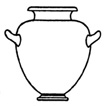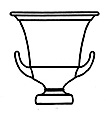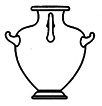| Hydria The name of this three-handled vase is derived from the Greek word for water. Hydriai were used for drawing water, as ballot-boxes, and also as urns to hold the ashes of the dead. They are commonly seen in vase-representations of women drawing water at the fountain-house. |
|
Loutrophoros The name of this vase means "carrier of washing-water", and the vase was used only in ritual contexts: at weddings, to carry the water for the bridal bath; in funerals, to carry the water for washing the corpse of unmarried persons and to mark their graves. Vases of this shape are commonly decorated with scenes of mourners or wedding processions. |
|
Lebes Gamikos This vase-type has three pieces: a bowl with handles, a lid (not shown here), and a stand. The term means "marriage bowl," and the vase was used for the same purpose as the loutrophoros in wedding rituals--to bring water for the bridal bath. Many of these vases are decorated with scenes depicting wedding preparations or wedding processions. |


















